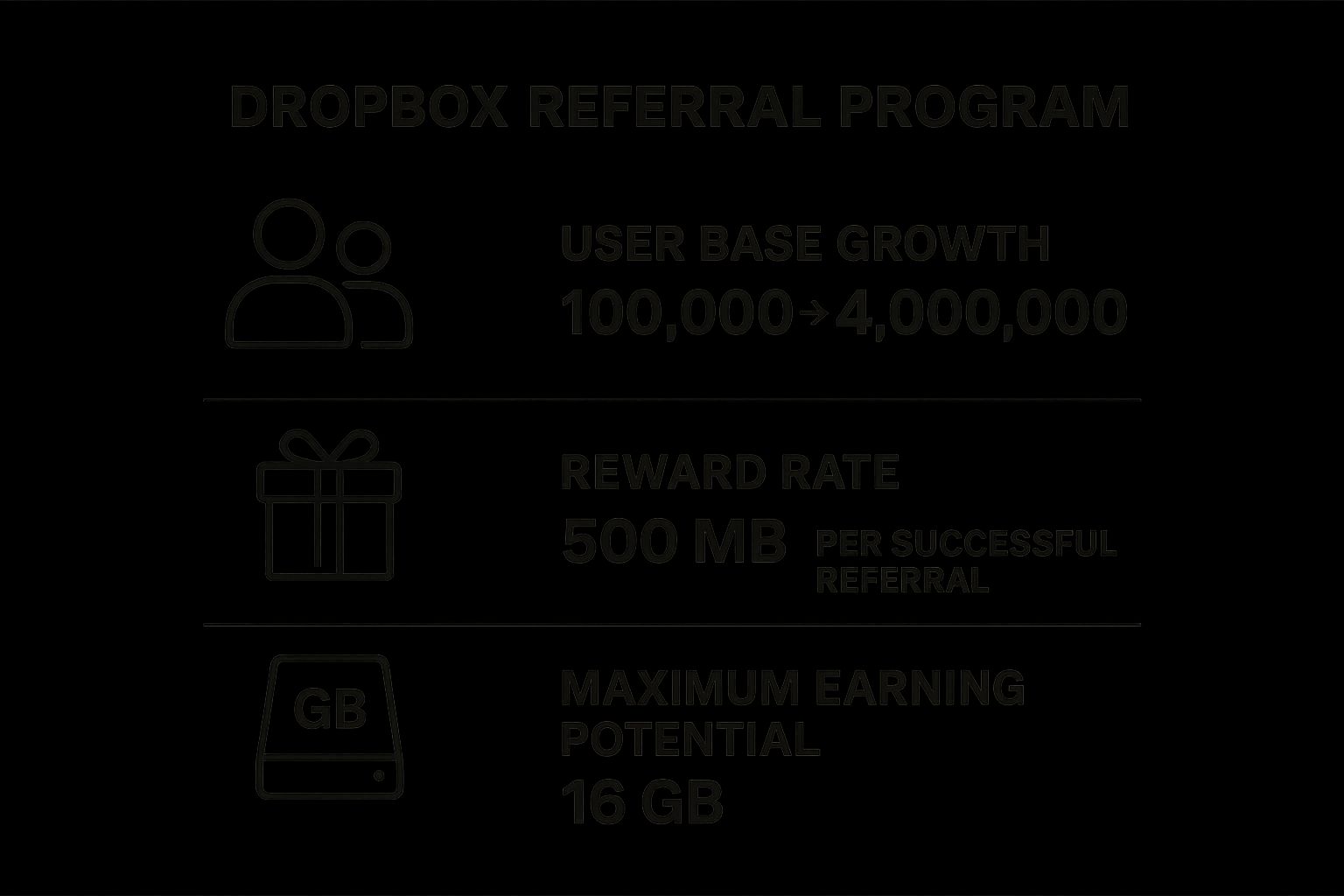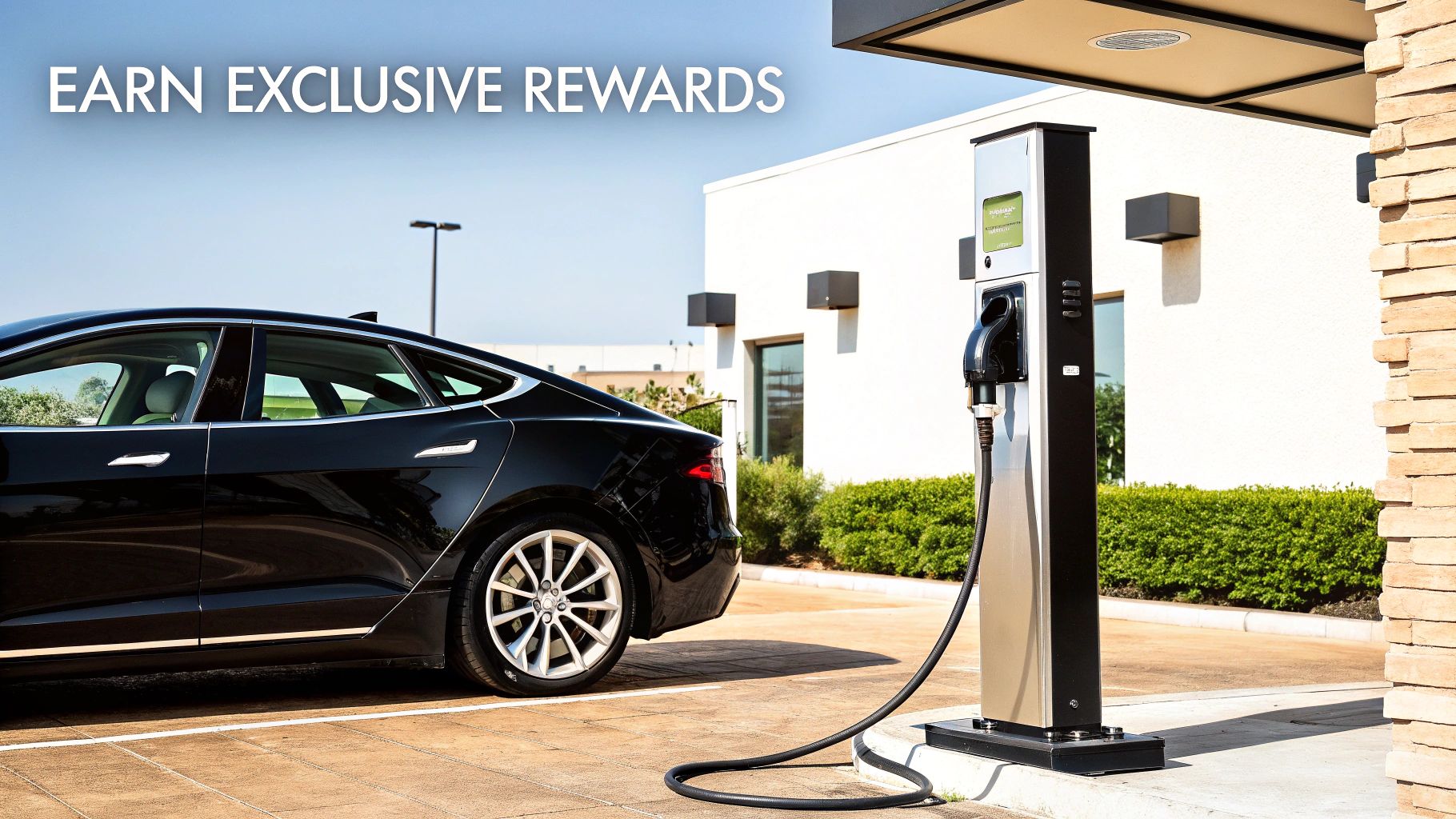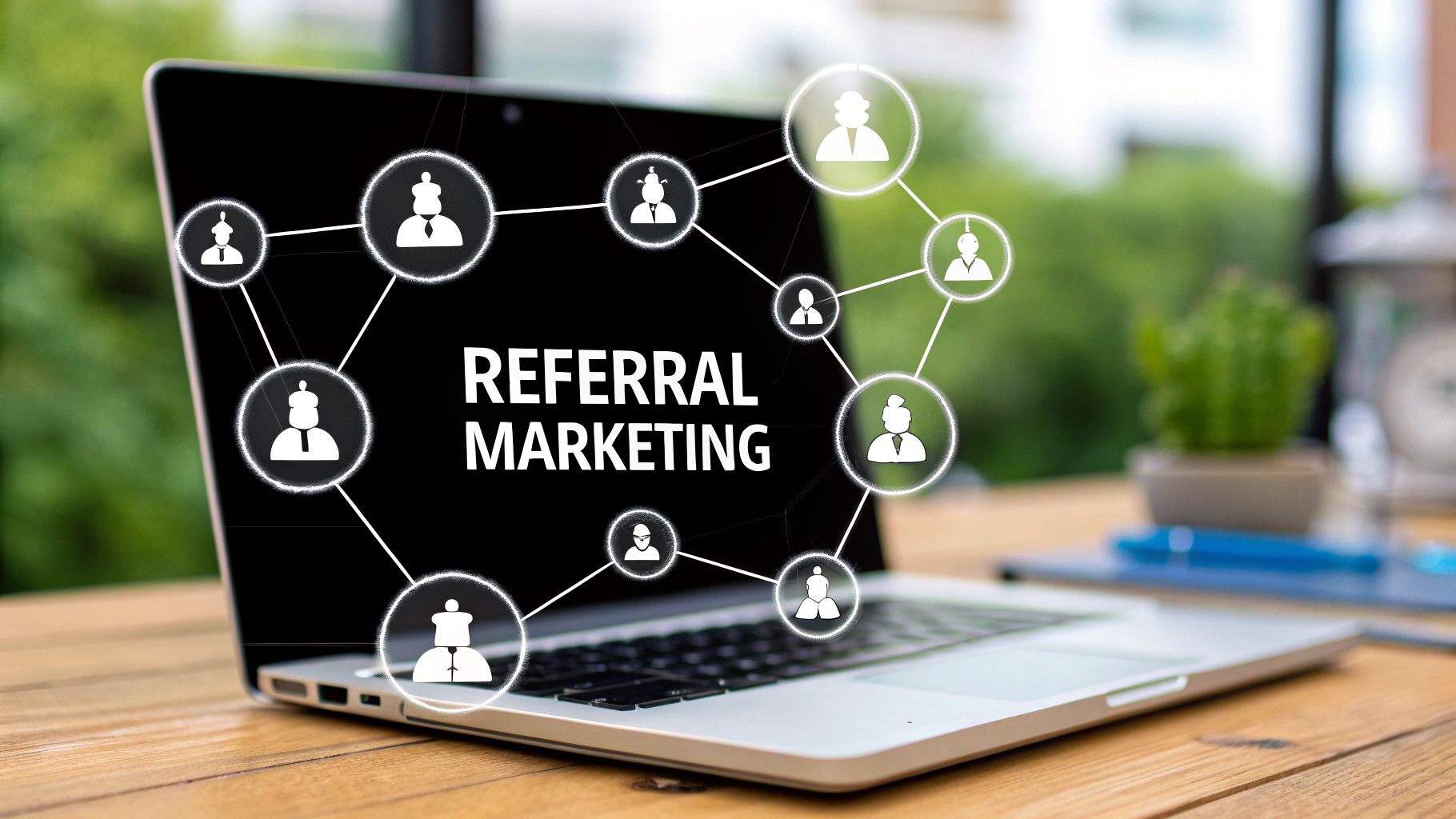Referral Marketing: The Growth Multiplier
In this listicle, you’ll discover six standout examples of referral marketing campaigns—from Dropbox’s simple sharing incentive to Robinhood’s waitlist strategy. Each case study reveals actionable tactics that SaaS founders, indie hackers, and product-led teams can adapt for self-serve growth. Learn why empowering users as advocates drives sign-ups, cuts acquisition costs, and accelerates momentum. You’ll walk through the key ingredients behind each program—reward mechanics, user experience design, and growth metrics—to build your own cost-effective growth engine. Dive in to see how Dropbox, Airbnb, Tesla, PayPal, Harry’s, and Robinhood turned customers into acquisition engines—and why each is a prime example of referral marketing you can replicate.
1. Dropbox Referral Program
The Dropbox Referral Program is a classic example of referral marketing that fueled massive growth by offering double-sided incentives directly tied to the product’s core value: storage space. Every time a user invited a friend and both signed up, the referrer and referee each earned 500 MB of free space—up to 16 GB total. This simple, product-related reward turned existing customers into powerful advocates and drove Dropbox’s user base from 100,000 to 4 million in just 15 months.

This “example of referral marketing” works by aligning user motivation with product usage: more storage means happier users who are incentivized to spread the word. The program’s ease of use—sharing a customized link via email, social media, or copy-and-paste—ensured frictionless participation, while a dashboard tracked earned rewards in real time.
Here’s an infographic visualizing the key data behind Dropbox’s referral engine:

This stats display highlights:
- Growth from 100 000 to 4 000 000 users in 15 months
- 500 MB rewarded per successful referral
- Up to 16 GB of free space unlocked
- 30% of new sign-ups via referrals at peak
- 60% reduction in customer acquisition cost
These numbers demonstrate how tying rewards to your product’s utility not only spurs viral loops but also sustains long-term engagement.
Why It Works and When to Use It
The Dropbox model shines for early-stage SaaS, self-serve, and product-led companies that can allocate incremental usage-based perks. By offering something users truly value—extra storage in Dropbox’s case—you:
- Boost word-of-mouth and organic reach
- Lower acquisition costs through peer endorsement
- Increase lifetime value as both referrer and referee stay active to use their rewards
Consider a referral program when your product has scalable, low-marginal-cost features (like cloud space, extra seats, or premium trial days) and when you’re ready to leverage existing users to drive growth.
Key Features
- Double-sided incentive structure (rewards for both parties)
- Tiered rewards system (cumulative up to 16 GB)
- Product-related rewards that encourage usage
- Simple referral mechanism (unique shareable links)
- Transparent tracking dashboard
Pros and Cons
Pros:
- Zero direct customer acquisition cost
- Exponential viral growth potential
- Higher customer lifetime value from referred users
- Increased engagement as users redeem rewards
- Built strong word-of-mouth marketing
Cons:
- Requires giving away valuable product features
- Limited by the size of users’ social networks
- Eventual saturation point in mature markets
- Potential for gaming the system with fake accounts
Actionable Tips
- Tie rewards directly to your product’s core value.
- Make sharing frictionless—offer one-click email/social links and pre-written messages.
- Display progress visually to motivate continued sharing.
- Implement fraud prevention (e.g., email verification, IP checks).
- A/B test different reward sizes and tiers for optimal ROI.
For a deeper dive into how Dropbox perfected its referral funnel—and to see more “example of referral marketing” case studies—Learn more about Dropbox Referral Program.
2. Airbnb Referral Program
Airbnb’s referral program is one of the most-cited examples of referral marketing in the sharing economy. By rewarding both the referrer and the new user with travel credits, Airbnb drives high-value customer acquisition, deepens engagement, and amplifies word-of-mouth growth.
How It Works
- Personalized Referral Links: Every Airbnb user receives a unique link or code they can share via email, social media, messaging apps, or directly from the web or mobile app.
- Dual-Sided Incentives: When a friend signs up and completes a qualifying stay or experience, both parties earn travel credits (typically $25–$75, depending on region and offer).
- Data-Driven Optimization: Airbnb employs rigorous A/B testing and user-behavior analysis to tailor reward amounts by market, maximize conversion rates, and reduce fraud.
Why This Example of Referral Marketing Works
- High-Value Actions: Rewards are tied to completed bookings (not just sign-ups), ensuring new users are truly engaged.
- Shared Benefit: Both referrer and referee receive credits—boosting motivation on both sides.
- Seamless UX Integration: The referral flow lives inside Airbnb’s app and website, reducing friction.
- Market-Specific Rewards: Airbnb adjusts credit amounts to match local booking values, preventing over- or under-incentivization.
Key Features
- Double-sided cash incentive structure
- Market-specific reward values ($25–$75)
- Personalized referral links and email templates
- Mobile and web integration for one-click sharing
- Multiple sharing channels: email, Facebook, WhatsApp, SMS
Real-World Impact & Metrics
- Achieved 900% year-over-year growth immediately after launch
- Referred users exhibit 25% higher booking conversion rates versus non-referrals
- Program has driven millions in incremental bookings revenue
Pros and Cons
Pros:
- Drives high-quality customer acquisition
- Creates immediate engagement for new users
- Increases booking frequency among existing users
- Builds trust via friend recommendations
- Enables data-driven optimization
Cons:
- Higher direct cost compared to product-based or swag rewards
- Requires robust fraud monitoring to prevent abuse
- Effectiveness varies by market and user segment
- Credits expire after a set timeframe if unused
When & Why to Use This Approach
Use a dual-incentive, travel-credit–style referral program when:
- Your product has high customer lifetime value (CLTV), justifying larger rewards.
- You can track and reward users only after a valuable action (e.g., a paid subscription or purchase).
- You have sufficient scale to customize incentives by geography or segment.
Why it works for early-stage startups and SaaS:
- Demonstrates clear ROI on incentive spend
- Leverages existing user base for growth at a lower CAC than paid ads
- Offers immediate utility—travel credits or feature credits—that drive repeat engagement
Actionable Tips for Your Own Program
- Segment & Personalize: Tailor referral messages by user persona or past behavior.
- A/B Test Rewards: Experiment with different credit amounts and structures (fixed vs. tiered).
- Implement Fraud Detection: Use device fingerprinting, rate limits, and manual reviews.
- Automate Email Reminders: Send timely nudges to both referrers and referees.
- Analyze User Journeys: Identify “aha” moments to trigger referral asks (e.g., post-checkout).
Further Reading & Resources
For more on this example of referral marketing and to launch your own program, visit Airbnb’s referral page:
https://www.airbnb.com/referrals
By combining tailored incentives, seamless sharing, and data-centric tweaks, Airbnb’s referral program remains a gold standard for startups and SaaS companies aiming to harness the power of word-of-mouth growth.
3. Tesla Referral Program
The Tesla Referral Program is a standout example of referral marketing that leverages passionate brand advocates to drive massive word-of-mouth sales. By issuing every Tesla owner a unique referral code, Tesla encouraged satisfied customers to recruit new buyers in exchange for escalating, exclusive rewards—ranging from free Supercharging credits and invites to VIP events, all the way up to complimentary vehicles like the Tesla Roadster.

How It Works
- Personalized Referral Codes: Each Tesla owner gets a unique URL or code to share via email, social media, or one-on-one outreach.
- Tiered Escalating Rewards: When a referred buyer takes delivery of a new Tesla, both the referrer and the referee unlock benefits. Small wins (e.g., free Supercharging miles) scale up to limited-edition collectibles, event access, or even free vehicles.
- Gamification & Community Recognition: Leaderboards, public shout-outs by Elon Musk on Twitter, and exclusive “Elite Referrer” status maintain momentum among power users.
Why It Deserves Its Place
• Proven ROI: At peak, the program drove an estimated 40% of Model S and Model X sales with minimal advertising spend.
• Community Building: High-engagement contests and limited-time reward windows fostered a tight-knit network of brand advocates who provided product feedback and organic buzz.
• Brand Exclusivity: Luxury and scarcity elevated the Tesla ownership experience, reinforcing premium positioning.
Pros
- Generated significant sales with minimal marketing spend
- Created a powerful community of brand advocates
- Fostered exclusivity and status among owners
- Provided valuable product feedback through owner network
- Reduced customer acquisition costs by an estimated 40–60%
Cons
- Became too costly as the program scaled
- Required frequent revisions to maintain sustainability
- Eventually set expectations that were difficult to manage
- Some high-tier rewards created delivery and logistics challenges
Successful Implementation Examples
- Top Tesla referrers like Bjørn Nyland earned multiple free vehicles worth over $250,000.
- During peak referral periods, certain owners referred more than 100 new buyers each.
- Referral sales accounted for 40% of the total Model S/X deliveries in a single quarter.
When and Why to Use This Approach
Use a tiered referral program when:
- You have a highly engaged, loyal customer base.
- Your product has a high lifetime value (LTV) that justifies generous rewards.
- You want to build brand exclusivity and community evangelism.
Actionable Tips for Startups & SaaS Founders
- Design Clear, Escalating Tiers: Start with small perks (discounts or credits), then unlock premium rewards (exclusive webinars, swag, or service add-ons).
- Balance Cost vs. LTV: Model your referral incentives against average customer LTV to ensure profitability.
- Gamify Participation: Publish leaderboards or host monthly referral contests to spark friendly competition.
- Set Clear Terms & Expiry: Prevent open-ended liability by defining reward caps, expiration dates, and eligibility criteria.
- Leverage Passionate Advocates: Identify top users, invite them into beta programs, or feature their success stories in your marketing.
For more details on how Tesla structured its program, visit Tesla’s official site: https://www.tesla.com/support/referral-program
By studying the Tesla Referral Program—an iconic example of referral marketing—early-stage startups and self-serve SaaS companies can craft their own tiered, cost-effective, community-driven strategies to amplify growth and reduce customer acquisition costs.
4. PayPal Early Growth Referral Program
The PayPal Early Growth Referral Program is one of the most cited examples of referral marketing in the tech world. Launched in the early 2000s, this program paid users $10 when they signed up and an additional $10 for each friend they referred. By offering direct cash incentives, PayPal was able to tap into powerful network effects, accelerate user acquisition, and create viral loops that drove exponential growth.
How It Works
- New users receive a $10 cash bonus upon account activation.
- Existing users earn $10 for every friend who signs up and completes their first transaction.
- Payouts are delivered instantly via PayPal’s own payment rails, reinforcing trust and immediacy.
- With a viral coefficient greater than 1, each participant on average generated more than one new signup.
Why This Is a Standout Example of Referral Marketing
- Explosive Early Growth
- 100,000 users acquired in the first month
- Sustained 7–10% daily growth at peak
- Over 5 million users within a few years
- Simplicity & Scale
- Clear, cash-based incentive that any customer could understand
- Minimal friction: just share a unique link, and watch rewards roll in
- Network Effects
- Critical mass achieved rapidly in a market where peer trust was essential for online payments
- Each referral not only added a user but also strengthened the PayPal ecosystem
Features & Benefits
- Direct cash rewards for both inviter and invitee
- Extremely simple value proposition—no points, tiers, or gamification
- Minimal barriers to participation: no coupon codes, no complicated milestones
- Native banking integration for instant reward delivery
- Viral coefficient >1 ensured each new user propelled further signups
Pros and Cons
Pros:
- Achieved explosive growth rate and market dominance
- Created immediate perceived value and strong word-of-mouth
- Easily understood by any demographic, fueling broad adoption
- Built network effects that made PayPal the go-to digital wallet
Cons:
- Very high cost per acquisition in early stages
- Attracted some “bonus hunters” who left once the incentive ended
- Opened the door to fraud and duplicate accounts
- Required tens of millions in funding to sustain
- Unsustainable long-term without evolving the incentive structure
When & Why to Use This Approach
Use direct cash-reward referrals when you:
- Are an early-stage startup or self-serve SaaS with a critical need for rapid user growth
- Rely on network effects—each additional user makes your product more valuable
- Have sufficient funding to absorb a high initial cost per acquisition
- Can implement robust fraud prevention to protect ROI
Avoid this model if:
- Your product’s lifetime value (LTV) is lower than the referral cost
- You lack the budget to sustain a large-scale cash giveaway
- Network effects are weak or nonexistent in your market
Actionable Tips for Your Own Program
- Calculate your true customer LTV before setting reward levels.
- Build fraud-prevention from day one (e.g., device fingerprinting, KYC checks).
- Define clear terms, limits, and expiry dates to control costs.
- Transition to lower-cost rewards (discounts, feature upgrades) as you scale.
- Monitor your viral coefficient: aim for >1 to ensure compounding growth.
PayPal’s early referral strategy remains an iconic example of referral marketing because it demonstrates how straightforward incentives, aligned with network-effect businesses, can drive supercharged adoption. For a deeper dive into the mechanics and lessons learned, see Learn more about PayPal Early Growth Referral Program.
Official Site: https://www.paypal.com/
5. Harry's Pre-Launch Referral Campaign
Harry’s Pre-Launch Referral Campaign is a standout example of referral marketing that helped the men’s grooming startup amass over 100,000 email addresses in just one week before launch. By leveraging a simple, gamified tiered reward system—ranging from free shaving cream for three referrals up to a year’s supply of blades for 25+—Harry’s turned every prospect into a potential brand advocate. This approach not only built anticipation and buzz but also validated demand and collected critical customer data before a single product left the factory.

What It Is and How It Works
At its core, this campaign used a two-page microsite where visitors signed up with their email address and received a unique referral link. Each referral unlocked a higher reward tier. The microsite displayed real-time progress bars, social sharing buttons (pre-populated for Facebook, Twitter, and email), and clear copy guiding users through each milestone. This streamlined experience lowered friction and motivated participants to share widely.
Why It Deserves Its Place
• Pre-launch implementation ensured Harry’s had a ready-made customer base at launch.
• The gamified, tiered structure kept momentum high—77% of the 100,000+ sign-ups came via referrals.
• Identified top referees (some brought in 50+ friends), creating an early cadre of brand ambassadors.
Key Features and Benefits
• Pre-launch implementation: Validate demand before product release.
• Gamified tiered rewards: Enhances motivation with clear milestones.
• Two-page microsite: Minimizes distraction and maximizes conversions.
• Product-based incentives: Demonstrates value of the actual offering.
• Progress tracking: Keeps referrers engaged and informed.
• Social sharing integration: Simplifies distribution and reduces user effort.
Pros and Cons
Pros:
- Built substantial audience before product availability
- Created anticipation and buzz
- Collected valuable customer data
- Minimized initial marketing costs
- Identified potential brand ambassadors early
Cons:
- Required fulfilling rewards to many users simultaneously at launch
- Created high expectations before product testing
- Logistical challenges with tracking and attribution
- Limited product knowledge among early referrers
Real Results
- 100,000+ emails collected in one week
- 77% of sign-ups via referrals
- Top referrers acquired 50+ friends each
- Customer acquisition cost far below paid advertising benchmarks
Actionable Tips
- Design a simple, visually appealing referral page with minimal clicks.
- Establish clear, achievable reward tiers tied to your product.
- Pre-populate share messages to make distribution frictionless.
- Send timed reminder emails to re-engage dormant referrers.
- Ensure your logistics and fulfillment systems can handle reward volume.
When and Why to Use This Approach
- Early-stage startups seeking pre-validation and buzz
- Product-led growth SaaS aiming to build a user base before feature lock-in
- Indie hackers wanting to minimize paid ad spend
- Situations where you can incentivize advocates with product samples or trial credits
By emulating Harry’s pre-launch referral campaign, you tap into a proven example of referral marketing that scales your audience quickly, builds credibility, and primes your launch for immediate success.
Learn more at Harry’s official website: https://www.harrys.com.
6. Robinhood Waitlist Referral Program
The Robinhood Waitlist Referral Program is a standout example of referral marketing that leverages exclusivity and priority access to drive massive pre-launch signups. Long before Robinhood’s mobile trading app went live in 2015, early adopters joined a waitlist—and could climb higher in line by referring friends. Each successful referral moved both the referrer and the new signup up the queue, creating a powerful incentive to share.
How it works
- A user signs up and receives a unique referral link.
- The user’s current position on the waitlist is displayed in real time.
- For every friend who signs up through that link, both referrer and referee advance a fixed number of spots.
- Users see live updates of the waitlist size and their personal rank, reinforcing social proof and sparking urgency.
This simple mechanic generated over 1 million users before the app even launched—an impressive testament to what a well-designed referral loop can do for user acquisition.
Why this example of referral marketing deserves its place
- Scarcity & Exclusivity: By promising earlier access, Robinhood turned a waitlist into a coveted status symbol.
- Viral Loop without Cash Cost: Rather than monetary rewards, Robinhood used priority access—a zero-cost incentive that still drove social sharing.
- Data & Press: Over 1 million prospective users meant valuable customer insights and a media narrative around “the app everyone’s talking about.”
Features & Benefits
- Waitlist Position Improvement as the incentive
- Real-time Position Updates via a live dashboard
- Dual Benefit: Both referrer and referee move up
- Transparent Queue Display builds trust and urgency
- Social Proof through waitlist size visibility
Pros and Cons
Pros
- Created scarcity and exclusivity at zero direct cost
- Generated valuable user data before launch
- Built anticipation, hype, and press coverage
- Encouraged organic social sharing and discussion
- Identified high-engagement early adopters
Cons
- Heightened expectations—failure to deliver quickly can backfire
- Potential disappointment for users stuck near the bottom
- Required robust infrastructure for real-time queue updates
- Diminishing returns once the product opens to all
When and Why to Use This Approach
- Pre-Launch or Beta Phases: Ideal for early-stage startups or SaaS that want to build a pipeline of engaged users before full rollout.
- Creating Buzz: If your product benefits from FOMO (fear of missing out) or exclusivity, a waitlist referral can amplify media coverage and word-of-mouth.
- Data Collection: Capturing emails and referral behavior helps you identify power users and tailor launch messaging.
Actionable Tips for Your Waitlist Referral Program
- Visualize Progress: Use a progress bar or rank indicator so users see exactly how many spots they’ve climbed.
- Be Transparent: Clearly explain how many referrals equal one jump up the list and how many people are currently waiting.
- Regular Status Updates: Email or push-notify users about their changing rank to keep them engaged.
- Combine Incentives: If you can afford it, layer on bonus perks (e.g., early feature access, swag) once users hit certain milestones.
- Plan Your Rollout: Stagger invites post-launch to sustain momentum—don’t open the floodgates all at once.
Ready to learn more about how Robinhood built its pre-launch audience?
Learn more about Robinhood Waitlist Referral Program
Official site: https://robinhood.com
This example of referral marketing proves that exclusivity—backed by clear mechanics and real-time feedback—can be just as powerful as cash incentives in driving viral growth.
Referral Marketing Program Comparison
| Program | Implementation Complexity 🔄 | Resource Requirements ⚡ | Expected Outcomes 📊 | Ideal Use Cases 💡 | Key Advantages ⭐ |
|---|---|---|---|---|---|
| Dropbox Referral Program | Moderate: simple mechanism, tracking | Low: mainly product storage giveaways | High viral growth; user base expansion | SaaS/products with measurable product value | Zero direct acquisition cost; viral growth |
| Airbnb Referral Program | High: multi-channel, personalized links | Medium-High: cash credits, fraud systems | High-quality user acquisition, improved bookings | Marketplaces with high-value transactions | Data-driven optimization; strong user engagement |
| Tesla Referral Program | High: tiered rewards, gamification | High: exclusive rewards, event logistics | Significant sales; community & brand loyalty | Luxury/high-ticket products seeking exclusivity | Strong community; high sales with low marketing |
| PayPal Early Growth Program | Low to Moderate: straightforward rewards | Very High: direct cash incentives | Explosive early growth; market dominance | Network-effect businesses needing rapid scale | Fast acquisition; established market leadership |
| Harry's Pre-Launch Campaign | Moderate: tiered rewards, microsite | Medium: product giveaways, microsite setup | Large email list prior to launch; buzz creation | Pre-launch/startup campaigns seeking early hype | Built anticipation; low marketing cost |
| Robinhood Waitlist Program | Moderate: real-time queue updates | Low: technical queue management | High pre-launch signups; hype via exclusivity | Pre-launch products leveraging scarcity and hype | No direct cost; strong social proof |
Your Turn: Build a Winning Referral Program
Throughout this article, we’ve explored standout example of referral marketing in action—from Dropbox’s frictionless invites and Airbnb’s double-sided rewards to Tesla’s VIP experiences, PayPal’s viral growth loops, Harry’s pre-launch buzz, and Robinhood’s waitlist momentum. Each program shares core principles: make referrals effortless, reward both advocates and referees, and tap into genuine user enthusiasm to drive organic reach.
Key Takeaways
- Incentivize both sides: Double-sided rewards boost participation and long-term loyalty.
- Simplify the process: A one-click share or automatic credit reduces friction and accelerates adoption.
- Leverage exclusivity and social proof: Early access, VIP perks, and leaderboard gamification create urgency and buzz.
- Iterate and personalize: Tailor messaging to user segments and continuously optimize rewards for maximum impact.
Actionable Next Steps
- Define clear growth goals and referral KPIs.
- Map your ideal user journey, identifying where referral prompts fit naturally.
- Craft compelling rewards that resonate with your audience—consider credits, discounts, or premium features.
- Select a referral tool that integrates seamlessly with your product and analytics stack.
- Launch, measure performance, and refine to maximize your program’s viral loop.
Mastering these referral marketing strategies empowers you to acquire high-quality leads at a fraction of traditional ad spend, fueling sustainable, scalable growth for your early-stage startup or self-serve SaaS. By turning customers into passionate advocates, you not only lower customer acquisition costs but also build a community that champion your brand’s mission.
Now it’s your turn: use these proven examples of referral marketing as your blueprint, experiment boldly, and watch your user base expand organically. The most successful SaaS founders aren’t just building products—they’re igniting movements.
Ready to launch your referral program in minutes? Refgrow’s embeddable affiliate software makes it easy to replicate these “example of referral marketing” successes without the headache—so you can scale organically and drive sustainable SaaS growth. Get started with Refgrow.

